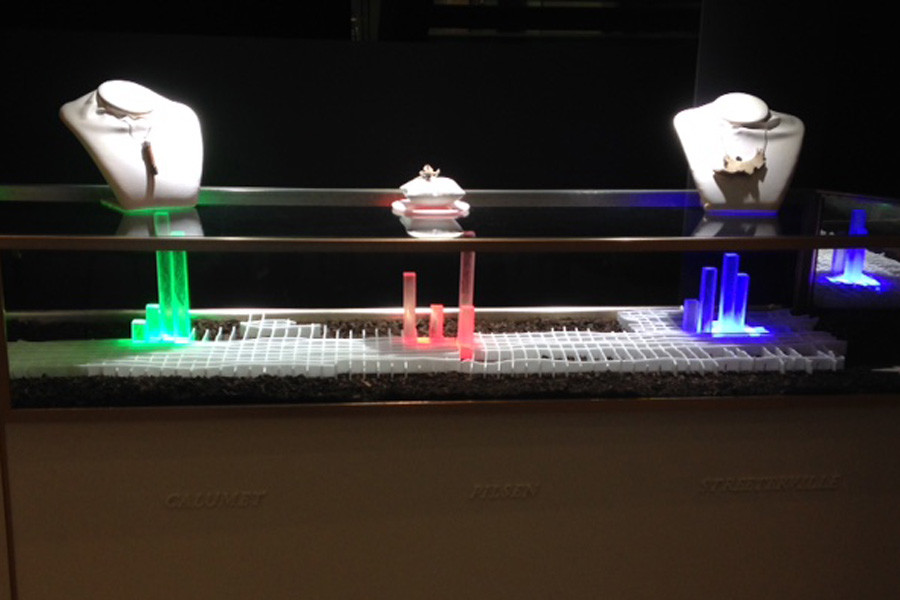NU, SAIC class transcends boundaries between engineering and art
Emily Chin/Daily Senior Staffer
An art piece depicting soil contamination in former industrial sites in Chicago is exhibited in the Data as Art showcase in the Ford Center. The art project is one of five that students in Data as Art, a combined class with the School of the Art Institute of Chicago, created.
February 3, 2016
A&E
A synthetic biology game, an interactive map of Chicago, data-influenced jewelry — these are all innovative projects made this past Fall Quarter by artists and engineers in Northwestern’s Data as Art class.
For the past three years, Data as Art, a collaboration between NU and the School of the Art Institute of Chicago, has brought NU engineers and SAIC artists together to study data sets and present them as visual art. Throughout the quarter, the class switched locations between The Garage at Northwestern and SAIC. This year’s Fall Quarter class created final projects that were originally put on display at SAIC in December and are currently on display at the Ford Center.
“The purpose of this class is to get engineers and artists to work together so that they can meld their different styles and different ways of thinking and learn from each other,” said Bruce Ankenman, co-director of the Segal Design Institute.
The class began three years ago when McCormick dean Julio Ottino recognized the need for analytical engineering students, accustomed to using the left side of their brains, to explore more creative right-brained activities, Ankenman said.
However, it also gives art students the chance to look into topics they might not examine regularly, SAIC Prof. Douglas Pancoast said.
“It’s a chance (for SAIC students) to work with real data, science and engineers, which is sort of represented here but not quite to the degree that it is at Northwestern,” he said.
Pancoast said one of the goals of the class was for the students to gain a deeper understanding of data. Students in the class looked at data sets — which featured information on Chicago transportation, synthetic biology and soil contamination — related to the research and expertise areas of the engineering faculty. During the course of the class, the students learned to comprehend and respond to the data before they could form their projects, Pancoast added.
SAIC Dean of Undergraduate Studies Tiffany Holmes said given today’s emphasis on and accessibility to big data, it is important for people to be able to understand and present it publicly.
“I think both artists and scientists have a responsibility to create new narratives from the enormous number of data sets that are being made publicly available,” she said. “I want the students to see if there is potential for a greater story to be told when you put people together from different backgrounds.”
For their final projects, students were split into five groups, with a combination of engineering and art students in each group. Engineers and artists were able to contribute different tools from their skillsets in order to complete the projects, Ankenman said. Students in this fall’s class created a game based on synthetic biology, a map illustrating lack of public transportation in low-income Chicago neighborhoods and more.
McCormick junior Charles Tokowitz said he decided to take the class in order to learn how to work with students of a different academic background. He said he noticed the class was more self-motivated and self-directed than what he was used to.
Tokowitz also noted that there were some similarities between the way he and his partner, an SAIC student, approached their project. They were both interested in social commentary from a design perspective, and because of this, were able to identify elements to explore in the project, he said.
Pancoast said he hopes others see the similarities between engineering, art and design that Tokowitz did, as well as the value of collaboration between students of different backgrounds.
“I think this class is a really interesting intersection where we’re connecting art and science,” he said. “There are a lot of artists and designers at our school who are examining the edges of other disciplines, who are trying to socialize it and turn it into something useful.”
Email: [email protected]
Twitter: @emchin24


